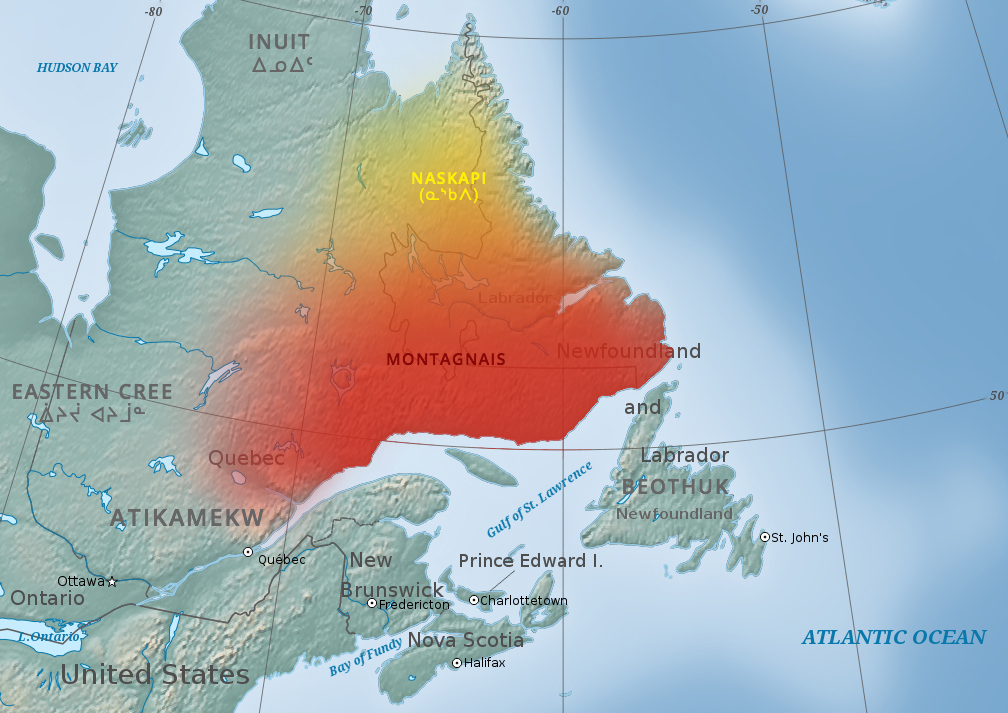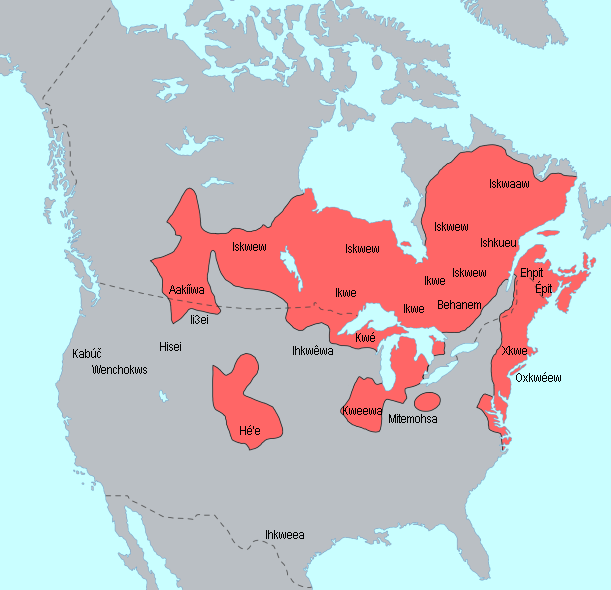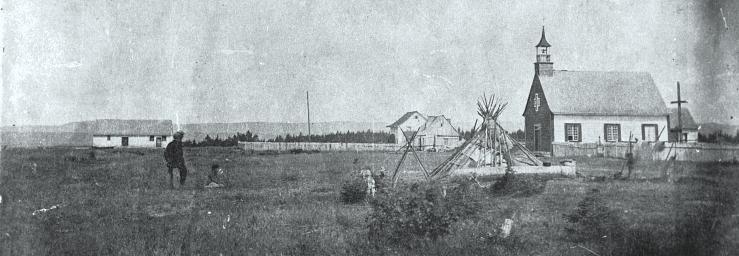|
Innus D'Ekuanitshit
Innus of Ekuanitshit (French: ''Les Innus d'Ekuanitshit'') are a First Nation band in Quebec, Canada. They live primarily in the Indian reserve of Mingan on the north coast of the St Lawrence River. , the band had a registered population of 677 members. Demographics Members of the band of Ekuanitshit are Innus. , the Nation had a total registered population of 677 members, of which 54 lived off reserve.. According to the 2016 Canadian Census, the median age of the population is 24.9 years old. Geography Innus of Ekuanitshit has only one reserve, Mingan, also called Ekuanitshit, where the band is headquartered and where lived the majority of its members.. The reserve is located on Quebec Route 138, west of Havre-Saint-Pierre in the Côte-Nord region in Quebec at the mouth of the Mingan River on the St Lawrence River. It covers an area of . The closest important city is Sept-Îles. Governance Innus of Ekuanitshit are governed by a band council elected according to a custo ... [...More Info...] [...Related Items...] OR: [Wikipedia] [Google] [Baidu] |
Innu
The Innu/Ilnu ('man, person'), formerly called Montagnais (French for ' mountain people'; ), are the Indigenous Canadians who inhabit northeastern Labrador in present-day Newfoundland and Labrador and some portions of Quebec. They refer to their traditional homeland as ''Nitassinan'' ('Our Land', ᓂᑕᔅᓯᓇᓐ) or ''Innu-assi'' ('Innu Land'). The ancestors of the modern First Nations were known to have lived on these lands as hunter-gatherers for many thousands of years. To support their seasonal hunting migrations, they created portable tents made of animal skins. Their subsistence activities were historically centred on hunting and trapping caribou, moose, deer, and small game. Their language, which changed over time from Old Montagnais to Innu-aimun (popularly known since the French colonial era as Montagnais), is spoken throughout Nitassinan, with certain dialect differences. It is part of the Cree–Montagnais– Naskapi dialect continuum, and is unrelated to ... [...More Info...] [...Related Items...] OR: [Wikipedia] [Google] [Baidu] |
Havre-Saint-Pierre
Havre-Saint-Pierre () is a municipality located on the north shore of the Gulf of St. Lawrence, in Côte-Nord region, Minganie RCM, Quebec, Canada. History In 1857, a group of Acadian families arrived, in 1872, the Parish of Saint-Pierre-de-la-Pointe-aux-Esquimaux was officially established, the same year its post office opened under the name Esquimaux Point. In 1873, the place was incorporated as a municipality. In 1924, the post office changed its name to Havre-Saint-Pierre, followed by the town in 1927, in order to focus on the harbor, which characterizes the area, while retaining the original parish name. It remained the largest town on the North Shore until 1936 when it was overtaken by Baie-Comeau. Since 1948, the Quebec Iron and Titanium Company mines deposits of ilmenite, a mineral composed of iron and titanium, at a site some north. The Chemin de fer de la Rivière Romaine brings it by rail cars to Havre-Saint-Pierre. Geography Havre-Saint-Pierre is located i ... [...More Info...] [...Related Items...] OR: [Wikipedia] [Google] [Baidu] |
First Nations In Quebec
Indigenous peoples in Quebec () total eleven distinct ethnic groups. The one Inuit community and ten First Nations communities number 141,915 people and account for approximately two per cent of the population of Quebec, Canada. First Nations Algonquian Abenaki The Abenaki comprise two First Nations communities named the Odanak First Nation (in Odanak, near Sorel) and the Wolinak First Nation (in Wôlinak, near Trois-Rivières). They are approximately 1,900 people on the two reserves. Anishinaabeg The Algonquin, who refer to themselves as ''Anishinaabeg'', comprise nine First Nations who live in communities located in the Outaouais and Abitibi-Témiscamingue regions of Quebec. These First Nations communities are: *Abitibiwinni First Nation in Pikogan * Algonquins of Barriere Lake in Lac-Rapide *Kebaowek First Nation (Eagle Village First Nation - Kipawa) in Kebaowek *Kitcisakik First Nation (Kitcisakik Anicinape Community) in Kitcisakik * Kitigan Zibi Anishinabeg in ... [...More Info...] [...Related Items...] OR: [Wikipedia] [Google] [Baidu] |
Indigenous And Northern Affairs Canada
Indigenous may refer to: *Indigenous peoples *Indigenous (ecology), presence in a region as the result of only natural processes, with no human intervention *Indigenous (band), an American blues-rock band *Indigenous (horse), a Hong Kong racehorse * ''Indigenous'' (film), Australian, 2016 See also *Indigenous Australians *Indigenous language *Indigenous peoples in Canada *Indigenous religion *Missing and Murdered Indigenous Women Missing and Murdered Indigenous Women are instances of violence against Indigenous women in Canada and the United States, notably those in the First Nations in Canada and Native American communities, but also amongst other Indigenous peoples s ... * Native (other) * * {{disambiguation ... [...More Info...] [...Related Items...] OR: [Wikipedia] [Google] [Baidu] |
Mamit Innuat Tribal Council
Mamit may refer to: * Mamit Innuat * Mamit, India, a town in Mizoram * Mamit district, a district of Mizoram * Mamit Assembly constituency Mamit is one of the 40 Legislative Assembly constituencies of Mizoram state in India. It is part of Mamit district Mamit district is one of the eleven districts of Mizoram state in India. Geography The district is bounded on the north by ..., an assembly constituency in India * Mamit Vanlalduatsanga, Indian professional footballer {{Disambig ... [...More Info...] [...Related Items...] OR: [Wikipedia] [Google] [Baidu] |
English Language
English is a West Germanic language that developed in early medieval England and has since become a English as a lingua franca, global lingua franca. The namesake of the language is the Angles (tribe), Angles, one of the Germanic peoples that Anglo-Saxon settlement of Britain, migrated to Britain after its End of Roman rule in Britain, Roman occupiers left. English is the list of languages by total number of speakers, most spoken language in the world, primarily due to the global influences of the former British Empire (succeeded by the Commonwealth of Nations) and the United States. English is the list of languages by number of native speakers, third-most spoken native language, after Mandarin Chinese and Spanish language, Spanish; it is also the most widely learned second language in the world, with more second-language speakers than native speakers. English is either the official language or one of the official languages in list of countries and territories where English ... [...More Info...] [...Related Items...] OR: [Wikipedia] [Google] [Baidu] |
French Language
French ( or ) is a Romance languages, Romance language of the Indo-European languages, Indo-European family. Like all other Romance languages, it descended from the Vulgar Latin of the Roman Empire. French evolved from Northern Old Gallo-Romance, a descendant of the Latin spoken in Northern Gaul. Its closest relatives are the other langues d'oïl—languages historically spoken in northern France and in southern Belgium, which French (Francien language, Francien) largely supplanted. It was also substratum (linguistics), influenced by native Celtic languages of Northern Roman Gaul and by the Germanic languages, Germanic Frankish language of the post-Roman Franks, Frankish invaders. As a result of French and Belgian colonialism from the 16th century onward, it was introduced to new territories in the Americas, Africa, and Asia, and numerous French-based creole languages, most notably Haitian Creole, were established. A French-speaking person or nation may be referred to as Fra ... [...More Info...] [...Related Items...] OR: [Wikipedia] [Google] [Baidu] |
Algonquian Languages
The Algonquian languages ( ; also Algonkian) are a family of Indigenous languages of the Americas and most of the languages in the Algic language family are included in the group. The name of the Algonquian language family is distinguished from the orthographically similar Algonquin dialect of the Indigenous Ojibwe language (Chippewa), which is a senior member of the Algonquian language family. The term ''Algonquin'' has been suggested to derive from the Maliseet word (), meaning 'they are our relatives/allies'. Speakers of Algonquian languages stretch from the east coast of North America to the Rocky Mountains. The proto-language from which all of the languages of the family descend, Proto-Algonquian, was spoken around 2,500 to 3,000 years ago. There is no scholarly consensus about where this language was spoken. Family division This subfamily of around 30 languages is divided into three groups according to geography: Plains, Central, and Eastern Algonquian. Of t ... [...More Info...] [...Related Items...] OR: [Wikipedia] [Google] [Baidu] |
Innu-aimun
Innu-aimun or Montagnais is an Algonquian language spoken by over 10,000 Innu in Labrador and Quebec in Eastern Canada. It is a member of the Cree–Montagnais–Naskapi dialect continuum and is spoken in various dialects depending on the community. Literature Since the 1980s, Innu-aimun has had considerable exposure in the popular culture of Canada and France due to the success of the rock music band Kashtin and the later solo careers of its founders Claude McKenzie and Florent Vollant. Widely heard hit songs with Innu-language lyrics have included "" ("Girl"), "" ("My Childhood"), "" ("Story") and in particular "" ("Take care of yourself"), which appeared on soundtrack compilations for the television series '' Due South'' and the documentary '' Music for The Native Americans''. The lyrics of Akua Tuta are featured on over 50 websites, making this one of the most broadly accessible pieces of text written in any native North American language. Florent Vollant has also rend ... [...More Info...] [...Related Items...] OR: [Wikipedia] [Google] [Baidu] |
Indian Act
The ''Indian Act'' () is a Canadian Act of Parliament that concerns registered Indians, their bands, and the system of Indian reserves. First passed in 1876 and still in force with amendments, it is the primary document that defines how the Government of Canada interacts with the 614 First Nation bands in Canada and their members. Throughout its long history, the act has been a subject of controversy and has been interpreted in different ways by both Indigenous Canadians and non-Indigenous Canadians. The legislation has been amended many times, including "over five major changes" made in 2002. The act is very wide-ranging in scope, covering governance, land use, healthcare, education, and more on Indian reserves. Notably, the original ''Indian Act'' defines two elements that affect all Indigenous Canadians: * It says how reserves and bands can operate. The act sets out rules for governing Indian reserves, defines how bands can be created, and defines the powers of "ba ... [...More Info...] [...Related Items...] OR: [Wikipedia] [Google] [Baidu] |
Band Council
In Canada, an Indian band (), First Nation band () or simply band, is the basic unit of government for those peoples subject to the ''Indian Act'' (i.e. status Indians or First Nations). Bands are typically small groups of people: the largest in the country, the Six Nations of the Grand River First Nation had 22,294 members in September 2005, and many have a membership below 100 people. Each First Nation is typically represented by a band council () chaired by an elected chief, and sometimes also a hereditary chief. As of 2013, there were 614 bands in Canada. Membership in a band is controlled in one of two ways: for most bands, membership is obtained by becoming listed on the Indian Register maintained by the government. As of 2013, there were 253 First Nations which had their own membership criteria, so that not all status Indians are members of a band. Bands can be united into larger regional groupings called tribal councils. A treaty council, or treaty association, has addit ... [...More Info...] [...Related Items...] OR: [Wikipedia] [Google] [Baidu] |
Sept-Îles, Quebec
Sept-Îles (, , ) is a city in the Côte-Nord region of eastern Quebec. Along with Brador, Quebec, Brador and Blanc-Sablon, Sept-Îles is one of the oldest places in the province. The population was 24,569 as of the 2021 Canadian census. The town is called Uashat, meaning "bay" in Innu-aimun. The city is well known for having major iron companies like Iron Ore Company of Canada and SFP Pointe-Noire iron ore transport service company. The city relies heavily on the iron industry. Sept-Îles has among the highest average wages and the highest average wage increases. It is among the northernmost places with a paved connection to the rest of Quebec's road network. The only settlements on the paved road network that are farther north are Fermont, Radisson, Quebec, Radisson and Chisasibi, the latter two of which are in the extreme western part of the province at the north end of the James Bay Road. The only other settlements at higher latitudes in the province are mostly isolated C ... [...More Info...] [...Related Items...] OR: [Wikipedia] [Google] [Baidu] |







